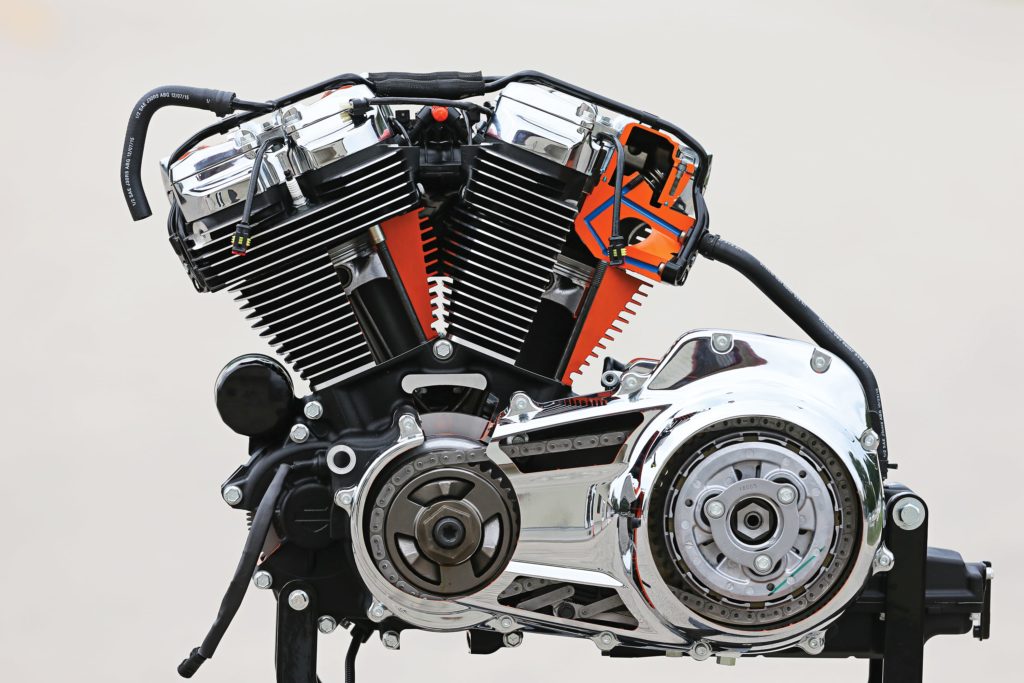The ‘wet sumping’ issues of Harley-Davidson’s Milwaukee Eight engine are well-documented. Sumping, if you don’t know, is the accumulation of oil in the bottom of the crankcase when the engine is run at high speeds for long distances. Sumping causes oil aeration, loss of power and excessive stress on engine parts, enough to actually break them. Not good. So far, most of the blame for this has been laid on the oil pump. But I’m not so sure. I have reason to believe that a second culprit has escaped notice. Namely, inadequate control of air pressure fluctuation and flow within the bottom end.
As the cliché says, “an engine is a pump.” True, but it’s not the whole story. Air compresses and oil doesn’t. Air has little inertia, while oil has a lot. Also, air, while it can’t compress oil, can sure as hell interfere with its flow. This is simple enough to grasp in theory but evasive in practice. For example, uncontrolled “open” breathing within the cases isn’t the answer, because that lacks any useful negative pressure (or vacuum) in the cases. Likewise, air that’s essentially being compressed inside the crankcases, and not moving, is worse.
In effect, air and oil are fighting for space and motion, and neither is winning. The problem at its core is compliance with “clean air” requirements, which makes for less-than-optimal air flow internally since nothing toxic is supposed to escape into the atmosphere. For instance, even a cursory look at H-D’s elaborate rocker box “breather” design shows more concern for oil getting out than air flowing through.
Oil pumps play a role in all of this that’s not all that well understood. Fact is, in a dry sump engine, like Harley’s, they go from not doing anything much at idle to being a controlling factor at high engine speeds, because they scavenge air as well as oil. This is a major reason H-D has revised the M8 oil pump so often.
Airflow in the crankcases allows more blow-by at idle because low engine speeds mean – relatively speaking – lots of “dwell” time, which allows air to pass the rings. Whereas at redline the reciprocating parts aren’t giving air enough time to flow by much of anything. The moving parts effectively become a “cork in the bottle” just as things are getting shaken up.
The tools we can use in attempting to create and tune air circulation in the crankcases are one-way airflow valves, which are never 100-percent effective because of rapidly changing dynamics inside an engine at different speeds.

At low engine speed, an airflow valve’s function synchronizes with the engine’s airflow demands, opening and closing efficiently with the rise and fall of the pistons, from idle to about 3500 rpm. Then, from 3500 – 4000 rpm, a V-twin engine starts to pass hotter gasses at higher pressures, pulsing in negative and positive pressure waves that become more erratic, at or beyond the limits of a mechanical valve’s ability to operate effectively.
The net result is still a slight vacuum in the cases, but the engine is making the rules and airflow valves can only follow them. This is when scavenging of both oil and air by the oil pump becomes a control factor. It also follows that if the oil pump cannot scavenge enough to keep up (or feeds too much), the engine will sump.
From roughly 4000 – 4500 rpm on up, the engine is continuously pumping air, pulsing above atmospheric pressure then going rapidly below it, fluctuating at near the speed of sound. At this point both the in and out airflow “control” valves are open all the time – which renders the valve mechanism essentially useless at high rpm. So the trick at this stage is to use valves with large body sizes and maximum flow capacities that will continue to maintain negative pressure in the cases. Here is where the factory breather system becomes an unwanted gatekeeper.
So, how do you add to, improve and control venting through an M8 engine/transmission to get quick and complete oil flow by means of improved internal air flow? Check back next time.
If you have any tech tips or questions or unsolvable motorcycle mysteries, email motorhead@thunderpress.net.



















The LiveWire is starting to look better.
Fueling Vented dipstick
My M-8 2018 is in the shop now. The motor started making all kinds of noise and rattling. They first changed the compensator then the noise came back even worse. Harley tells me the are changing cam , bearings , lifters and oil pump.
Do you think there should have been a recall on this engine in the beginning ??? I see there have been four revisions to the oil pump and I have one of the very early models.